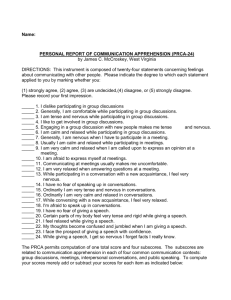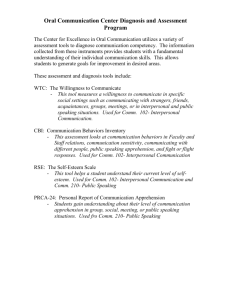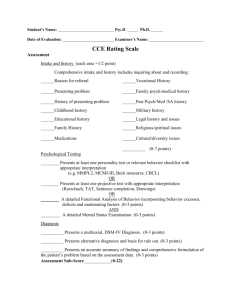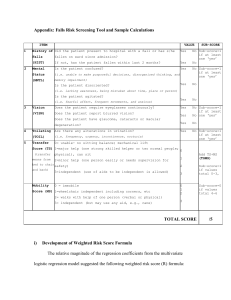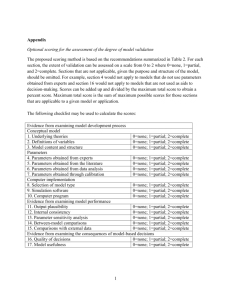Class Activity Background The Personal Report of Communication
advertisement
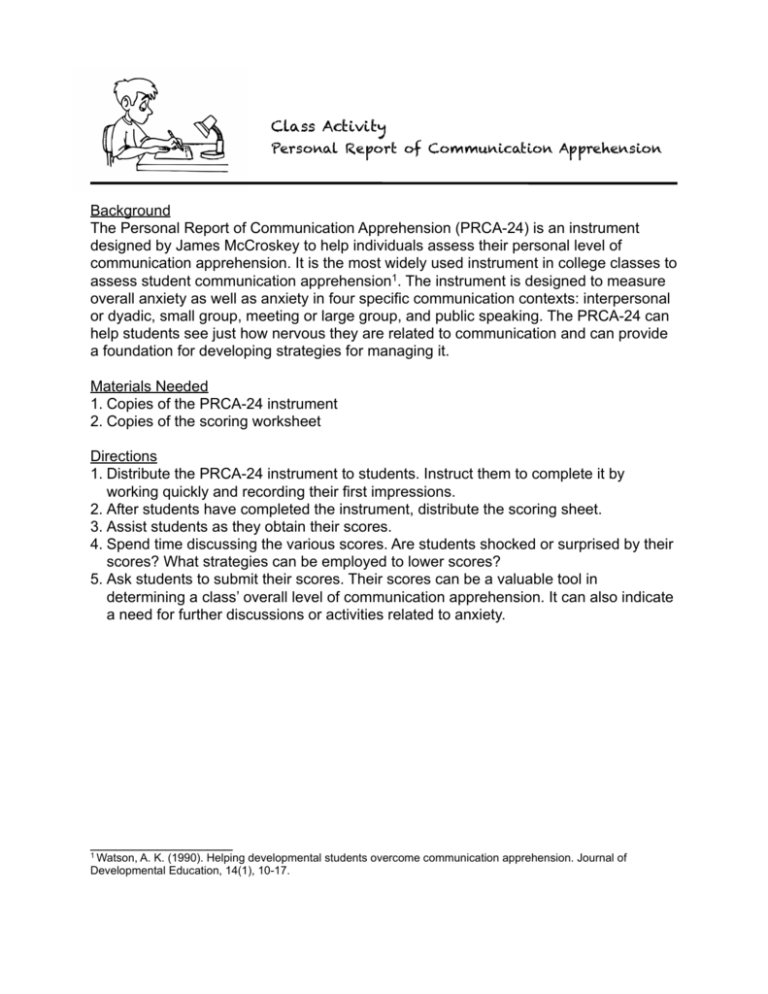
Class Activity Personal Report of Communication Apprehension Background The Personal Report of Communication Apprehension (PRCA-24) is an instrument designed by James McCroskey to help individuals assess their personal level of communication apprehension. It is the most widely used instrument in college classes to assess student communication apprehension1. The instrument is designed to measure overall anxiety as well as anxiety in four specific communication contexts: interpersonal or dyadic, small group, meeting or large group, and public speaking. The PRCA-24 can help students see just how nervous they are related to communication and can provide a foundation for developing strategies for managing it. Materials Needed 1. Copies of the PRCA-24 instrument 2. Copies of the scoring worksheet Directions 1. Distribute the PRCA-24 instrument to students. Instruct them to complete it by working quickly and recording their first impressions. 2. After students have completed the instrument, distribute the scoring sheet. 3. Assist students as they obtain their scores. 4. Spend time discussing the various scores. Are students shocked or surprised by their scores? What strategies can be employed to lower scores? 5. Ask students to submit their scores. Their scores can be a valuable tool in determining a class’ overall level of communication apprehension. It can also indicate a need for further discussions or activities related to anxiety. _________________ 1 Watson, A. K. (1990). Helping developmental students overcome communication apprehension. Journal of Developmental Education, 14(1), 10-17. Personal Report of Communication Apprehension (PRCA-24) Directions: This instrument is composed of twenty-four statements concerning feelings about communication with other people. Please indicate the degree to which each statement applies to you by marking whether you: (1) strongly agree, (2) agree, (3) are undecided, (4) disagree, or (5) strongly disagree. Work quickly; record your first impression. _____ 1. I dislike participating in group discussions. _____ 2. Generally, I am comfortable while participating in group discussions. _____ 3. I am tense and nervous while participating in group discussions. _____ 4. I like to get involved in group discussions. _____ 5. Engaging in a group discussion with new people makes me tense and nervous. _____ 6. I am calm and relaxed while participating in a group discussion. _____ 7. Generally, I am nervous when I have to participate in a meeting. _____ 8. Usually I am calm and relaxed while participating in a meeting. _____ 9. I am very calm and relaxed when I am called upon to express an opinion at a meeting. _____ 10. I am afraid to express myself at meetings. _____ 11. Communicating at meetings usually makes me feel uncomfortable. _____ 12. I am very relaxed when answering questions at a meeting. _____ 13. While participating in a conversation with a new acquaintance, I feel very nervous. _____ 14. I have no fear of speaking up in conversations. _____ 15. Ordinarily I am very tense and nervous in conversations. _____ 16. Ordinarily I am very calm and relaxed in conversations. _____ 17. While conversing with a new acquaintance, I feel very relaxed. _____ 18. I’m afraid to speak up in conversations. _____ 19. I have no fear of giving a speech. _____ 20. Certain parts of my body feel very tense and rigid while I am giving a speech. _____ 21. I feel relaxed while giving a speech. _____ 22. My thoughts become confused and jumbled when I am giving a speech. _____ 23. I face the prospect of giving a speech with confidence. _____ 24. While giving a speech, I get so nervous I forget facts I really know. Obtained from: http://www.jamescmccroskey.com/measures/prca24.htm. Original Source: McCroskey, J. C. (1982). An introduction to rhetorical communication (4th Ed). Englewood Cliffs, NJ: Prentice-Hall. Personal Report of Communication Apprehension (PRCA-24) Scoring Sheet Use the scoring sheet below to determine your levels of communication apprehension. For assistance, see the scoring example on page 2. Group Discussion Sub-Score 1. Add 18 + Items 2, 4, & 6: _____ 2. Add Items 1, 3, & 5: _____ 3. Subtract Line 2 from Line 1: _____ GROUP DISCUSSION SUB-SCORE – Line 3: _____ Meetings Sub-Score 1. Add 18 + Items 8, 9, & 12: _____ 2. Add Items 7, 10, & 11: _____ 3. Subtract Line 2 from Line 1: _____ MEETINGS SUB-SCORE – Line 3: _____ Interpersonal Sub-Score 1. Add 18 + Items 14, 16, & 17: _____ 2. Add Items 13, 15, & 18: _____ 3. Subtract Line 2 from Line 1: _____ INTERPERSONAL SUB-SCORE – Line 3: _____ Public Speaking Sub-Score 1. Add 18 + Items 19, 21, & 23: _____ 2. Add Items 20, 22, & 24: _____ 3. Subtract Line 2 from Line 1: _____ PUBLIC SPEAKING SUB-SCORE – Line 3: _____ OVERALL SCORE: Add 4 Sub-Scores:_____ PAGE 1 Scoring Example 2 1. I dislike participating in group discussions. 4 2. Generally, I am comfortable while participating in group discussions. 1 3. I am tense and nervous while participating in group discussions. 4 4. I like to get involved in group discussions. 2 5. Engaging in a group discussion with new people makes me tense and nervous. 4 6. I am calm and relaxed while participating in a group discussion. Group Discussion Sub-Score 1. Add 18 + Items 2, 4, & 6: 30 18 + 4 + 4 + 4 = 30 2. Add Items 1, 3, & 5: 5 2+1+2=5 3. Subtract Line 2 from Line 1: 25 30 – 5 = 25 GROUP DISCUSSION SUB-SCORE – Line 3: 25 Interpreting Your Score The table indicates scores that reflect both high and low levels of communication apprehension. Scores that are above the low and below the high indicate an average level of apprehension. High Low Group Discussion > 20 < 11 Meetings > 20 < 13 Interpersonal > 18 < 11 Public Speaking > 24 < 14 OVERALL > 80 < 51 Any sub-score above 18 indicates some degree of apprehension. PAGE 2
